Top News
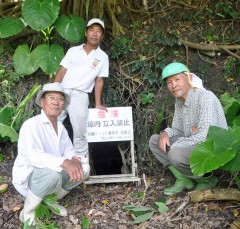
June 23, 2013 Ryukyu Shimpo
In June 2013, rocks falls inside the Tanabaru Shelter in Nishihara highlight the urgent need to carry out preservation work.
The local education board and a volunteer group for recovering war remains are searching inside the shelter, which the Imperial Japanese Army used as a field hospital during the Battle of Okinawa. There is no specific schedule for the preservation and repair work, but those involved commented that they want the municipal government to move as soon as possible to preserve the shelter.
Documents held by the town state that the shelter was built in Onaga in February 1945 for the 11th Independent Infantry Battalion stationed in the area. The battalion belonged to the 62nd Division. The army put 15 women living in Nishihara in the shelter as auxiliary nurses until dismissing them in May. Chobin Negawa, 80, who owns a field in front of the shelter, said, “Even now fingers bones appear when we plough the field. After the war we dug pits to bury many people who died in the shelter.”
Zensei Takaesu, who belongs to the volunteer group for recovering war remains, searched to find the shelter construction. It is built in the shape of an “E” with a tunnel over 60 meters long connected to 20 meter pathways running parallel from three entrances.
Takaesu said that you could find things from war in the shelter. However, rocks are falling all though it, making investigation a dangerous task.
A member of the local government said, “We do not have a clear schedule for preserving the shelter. But because of our stance on the promotion of peace we will consider this in future.”
Takaesu said, “We are able to return things to bereaved family members if the person’s full name is on it.” He went on to say, “We cannot preserve the shelter without help from the local government.”
Saburo Tamanaha, 71, who serves as a history guide in the town, said, “I want the local government to carry out the preservation work as soon as possible.”
(English translation by T&CT, Mark Ealey)
Go to Japanese
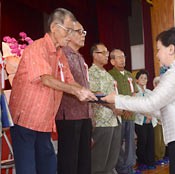
June 20, 2013 Ryukyu Shimpo
On June 19, a graduation ceremony was held at Kitanakagusuku Elementary School for graduates who were unable to receive their certificates due to the war. Seventeen people who were due to graduate in March 1945 are now at least 80 years old. They were happy to be receiving their certificates 68 years later, but could not but cast their minds back to their classmates who died during the war.
All the 763 current pupils of Kitanakagusuku Elementary School, the graduates’ families, Kitanakagusuku Mayor Kunio Arakaki, members of the Board of Education and the Assembly attended the ceremony. The graduates entered the venue to applause from pupils and joined in singing the school song. In place of Seiki Shimabukuro, who was the principal of Kishaba Elementary School in 1945, current principal Hiromi Ishiki handed over the graduation certificates. Remembering the war, some graduates shed tears as they received their certificates.
On behalf of the graduates, Kazumi Asato said, “When we were in the sixth grade we were not able to go to school because of the war and the situation around us was so bad that we couldn’t study. There is nothing so stupid as war.” He expressed his delight, saying, “Fortunately we survived and now are very happy that so many people celebrate our graduation.”
Representing the current pupils, Shutaro Higa, who is in the sixth grade at Kitanakagusuku Elementary School, said, “I have had a think about the difficulties and terrible things that come with war. I want to think about what we can do to help create a world without war.”
Principal Ishiki said, “All of our pupils and staff sincerely rejoice on the occasion of our seniors’ graduation. I think that their friends who died during 68 years would also be happy that this ceremony has been held.”
(English translation by T&CT, Lima Tokumori and Mark Ealey)
Go to Japanese
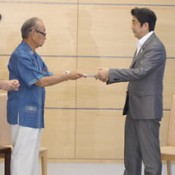
June 13, 2013 Ryukyu Shimpo
On June 12, Governor Hirokazu Nakaima and 27 mayors met Prime Minister Shinzo Abe in Tokyo. They asked him to provide more detail about the plan to return U.S. bases and land south of Kadena Air Base, and for information on the alternatives to the closed bases. The Governor and mayors went to Tokyo as members of the Okinawa Municipal Council for Military Land Conversion and Base Problems, which is made up representatives of the 27 municipalities in Okinawa that host U.S. military bases. The Prime Minister said, “I would like to discuss this with you all to move things forward smoothly.”
Mayors from seven municipalities attended the meeting. Asking for detail regarding the process of returning the land, the Governor said, “We do not know where you intend to move what facilities.” They asked the government to listen to the opinions of the Okinawa Prefectural Government and municipalities when it carries out the consolidation plan, and the master plan for the remaining bases. In response, the Prime Minister asked them to be more understanding towards the government’s plan, saying, “There is another party (the United States) involved. It is difficult in this situation for the Japanese Government to just say ‘Yes, okay.’”
Governor Nakaima again asked the Prime Minister to cancel the deployment of the MV-22 Osprey aircraft, saying, “Our concerns over the aircraft’s safety have not been resolved.” The Prime Minister said, “It will operate based on the agreement of the Japan-U.S. Joint Committee to protect residents’ safety.” He did not comment on the plan to move Osprey-related training from Okinawa to other prefectures.
After the meeting, Governor Nakaima said to the media, “His (the Prime Minister) comments were not specific, but he did said that he wants to reduce the burden on Okinawa.”
Nago Mayor Susumu Inamine told the Prime Minister that the consolidation plan for U.S. bases, which is basically a package proposal including the relocation of the Futenma base within Okinawa, will not move ahead.
Cabinet Secretary Yoshihide Suga attended the meeting. Governor Nakaima and the mayors made the same request to Foreign Minister Fumio Kishida and Minister of State for Okinawa Ichita Yamamoto.
(English translation by T&CT, Megumi Chibana and Mark Ealey)
Go to Japanese
June 21, 2013 Ryukyu Shimpo
Members of the Yonaguni Town Assembly have unanimously passed a bill leasing land owned by the town to the Ministry of Defense. This will enable the Japan Self-Defense Forces (SDF) to station a coast guard unit on the island. We question such a plan being pushed forward, with almost half of local voters opposing it.
The municipal office will lease 21.4 hectares of the town’s farmland to the ministry for about 15 million yen a year.
The ministry wanted to rent the land for five million yen a year, but this month it agreed to the town’s demands that they pay an amount equal to that for land used for building on. This has increased the amount due by three times. In the use of public funds, is it acceptable that the ministry pays building land rental fees for farmland?
There is a reason the ministry accepted the rent increase. This March, Yonaguni Mayor Moriyoshi Hokama demanded an increase in rent and one billion yen as compensation for the inconvenience the town will face. However, on March 14 the mayor withdrew his demand for compensation, and with this, the ministry accepted the rent increase.
Hokama retracted his demand despite claiming in April that the price proposed by the ministry would not bring about positive economic benefit to the island. While Hokama stated that he “would not budge an inch” on this demand, there is a reason for the retraction.
The ministry has started considering measures to promote the island by improving infrastructure for the fishery industry and solid waste management. Hokama said, “In a deal carried out behind the scenes, the ministry will pay a billion yen toward the cost for improving these buildings.” Is it acceptable for the municipal office to be swayed by money politics into accepting this plan to station an SDF unit on Yonaguni?
While the town claims that the unit will bring benefits to the island and revitalize the local economy, the SDF states that this will reinforce the defense in the southwestern region. The town and the ministry are working toward different goals.
Hokama has claimed that the stationing of SDF personnel there will benefit the island economically. However, on Tsushima Island, which hosts a SDF base, the population continues to decline. It is an illusion to think that an SDF unit on the island will promote the local economy.
The ministry plans to station a 100-man strong coast guard unit on Yonaguni. On June 2, the number of eligible voters was 1,212. Some of the SDF personnel will bring family members with them. The SDF personnel and their families will account for ten percent of all the voters. This will influence the island’s politics, undermining local autonomy.
We would prefer to support the proposal from the town in 2005 of creating a special zone for exchange with Taiwan, but the Japanese government dismissed this idea. It is distorted politics that the central government forces Yonaguni to accept an SDF unit. An island located on a national boundary should be promoting international exchange. It is counter-productive to cause conflict by stationing a military force on the island.
(English translation by T&CT, Mark Ealey)
Go to Japanese
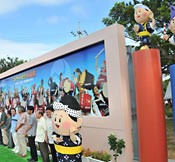
June 18, 2013 Ryukyu Shimpo
On June 13, the Okinawa Zento Eisa Festival Executive Committee held a ceremony to commemorate the completion of the “Eisa Dance Monument” in Koza Athletic Park, Okinawa City. This day marks six years since the Okinawa City declared itself as the “Town of Eisa dance.” The monument is third of its type following those that have been erected at the Raikamu Intersection and the Goya Crossroads. It costs about 4.5 million yen, which are donations from the residents’ associations and companies.
The monument has an advertising display about four meters high and 14 meters wide, on which there is a large photograph of eisa performance by youth groups in the city. It also has four statues of Okinawa city’s image character of “Town of Eisa,” including Eibo, Sarchan and others, standing on either side.
Dozens of people attended the ceremony, including municipal officials, members of the assembly and business people.
In her speech, Okinawa City Mayor Mitsuko Tomon said, “An image of the Town of Eisa has been spreading among people in the city and beyond. We want to work to attract more tourists.”
(English translation by T&CT, Mark Ealey)
Go to Japanese
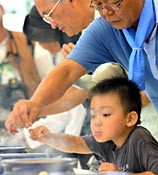
June 24, 2013 Ryukyu Shimpo
On June 23, the day commemorating 68 years after the battle of Okinawa ended, the Okinawa Prefectural Government and Assembly held the Okinawa Memorial Service for all the war dead at the Peace Memorial Park, Mabuni in Itoman. Those present prayed for the souls of the more than 200,000 people killed in the battle and vowed to create lasting peace in the world. Such memorial services were held at various war monuments around Okinawa. In her speech, the chairwoman of Bereaved Families of Okinawa Prefecture War Dead Joint Association Naeko Teruya referred to the people’s growing opposition to the plan to relocate the facilities at U.S. Marine Corps Air Station Futenma to Henoko, Nago, and the additional deployment of MV-22 Osprey to Futenma this summer. She said, “There is no way that we bereaved families can accept these things. We want to have the Futenma base moved out of Okinawa.” Chairman of the Okinawa Prefectural Assembly Masaharu Kina voiced the feelings of the people saying, “We are reaching the limits of our patience towards the unjust treatment that is repeatedly forced upon the Okinawan people.”
Early that morning, many people visited the Peace Memorial Park to place flowers by the engraved inscriptions on the Cornerstone of Peace. Some older people told their children and grandchildren about their experiences during the war while tracing their fingers on the names of the war dead. People in the peace memorial parade departed from Itoman City Hall at 9:00 a.m., joining the memorial service after walking through the area that had been the bloodiest battlefield in the southern part of Okinawa Island.
About 5,800 people, including families of victims and distinguished guests attended the ceremony. At noon, everyone bowed their heads to offer silent prayers. In addition to Prime Minister Shinzo Abe, House of Representatives Speaker Fumiaki Ibuki and President of the House of Councilors Kenji Hirata, Foreign Minister Fumio Kishida, Defense Minister Itsunori Onodera and U.S. Ambassador John Roos took part. This is the first time that the foreign minister and defense minister have attended this ceremony. In the peace declaration of memorial service, Okinawa Governor Hirokazu Nakaima stressed, “We will pass on the lessons learned from the tragedy of the Battle of Okinawa. We have a strong desire to preserve the pacifist stance that Japan has created.” The governor referred to the no war clause of Article 9, which is the underlying principle of the Constitution of Japan. It could be viewed that the governor was expressing concern about the movement by the Abe administration to amend the constitution. Prime Minister Abe said, “Concentrating U.S. military bases in Okinawa has become a major burden on the people. I will do my best to lessen this even a little.”
Yuki Asato, a first-grade pupil of Kubura Elementary School on Yonaguni Island, was applauded when he read out his poem entitled, “Peace, it’s really nice.” This year, the Okinawa Prefectural Government has added the names of a further 62 people to the inscription on the Cornerstone of Peace, bringing the total number to 241,227.
(English translation by T&CT, Mark Ealey)
Glossary
Okinawa Memorial Service for war dead
This service was first held in 1952 under the United States’ administration, but now, the Okinawa Prefectural Government holds it annually. In the 33rd Memorial Service in 1977, the 32nd anniversary of the Battle of Okinawa, then Governor Koichi Taira first read out a peace declaration designed to realize lasting world peace. In 1990 Toshiki Kaifu became the first serving prime minister to attend the ceremony.
Go to Japanese

Go To Video
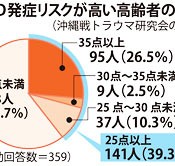
June 19, 2013 Ryukyu Shimpo
Psychiatrists and other specialists in Okinawa have looked into post-traumatic stress disorder (PTSD) issues among Battle of Okinawa survivors. They have found that about 40 percent of elderly Okinawa residents who experienced the Battle of Okinawa are likely to have the disorder. Those involved in the study believe that the memories of the Battle of Okinawa, the continued presence of U.S. military bases in Okinawa after the war and crimes and incidents related to the bases, have contributed to their disorder.

IES-R
This is the first time that the researchers have conducted a large-scale study on psychological damage from the Battle of Okinawa.
Between April 2012 and February 2013, psychiatrists and former health nurses randomly selected 401 Okinawans 75 years and older who used day service care in eight areas such as Itoman, Yomitan and Zamami. Those involved in the study interviewed the subjects. The researchers questioned them on 22 topics, using the Impact of Event Scale-Revised (IES-R), a self-report measure that assesses subjective distress caused by traumatic events. The measure yields a total score ranging from 0 to 88. The IES-R scale defines those with scores of 25 points or higher as the PTSD high-risk group.
The average age of the subjects was 82.3 years. The researchers received valid responses from 359 individuals, for whom the average score was 22.4. The number of those with scores higher than 25 were 141, accounting for 39.3 percent of the total. A 77-year-old woman scored 78 points, which was the highest.
(English translation by T&CT, Mark Ealey)
Go to Japanese
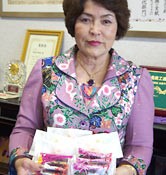
June 19, 2013 Ryukyu Shimpo
The Sweet Bakery Porsche Co. has won the Honorary President Award in the technical section of the 26th National Confectionery Great Exhibition held in Hiroshima with its Princess Moon Mango & Shikuwasa set.
First released in June 2011, this sweet scored highly in a comprehensive review of taste, packaging and name recognition. The company also won the Commissioner Award of the Japan Tourism Agency with its Beni-imo raw tart and was awarded the Director General Award of the Food Industry.
Its leading product, Beni-imo tart, recorded the second highest earnings in a sales corner during the event of 27 million yen.
Company president Kazuko Takushi said, “The growing popularity of Okinawa as a tourist destination means that its sweets are becoming more popular across the country.”
About 800,000 people visited the 26th National Confectionery Great Exhibition held from April 19 to May 12.
The company won the Honorary President Award (cultural section) with its Beni-imo tart in the 2008 exhibition held in Himeji.
(English translation by T&CT, Mark Ealey)
Go to Japanese
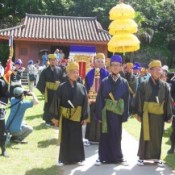
June 16, 2013 Ryukyu Shimpo
On June 15, the Kume-soseikai held an inauguration ceremony for the New Kume Confucian Temple in the Kume district of Naha. They carried out a parade to move the mortuary tablet of Confucius from the temple at Wakasa to the new temple.
The Kume-soseikai is an incorporated association set up in 1914 by Chinese descendents known as the “Thirty Six Families of Kume.” In the morning before the ceremony began, they moved the mortuary tablets enshrined in the temple of Wakasa to the new temple. About 150 people walked through the city to the sound of firecrackers. The mortuary tablets have come back to their original place in Kume for the first time in 69 years since the Kume temple was destroyed in the Battle of Okinawa.
The main gate of the temple, which is normally closed, was open so as to welcome to the mortuary tablet and parade of people. Students of Uenoyama Junior High School bearing a banner led the parade.
Standard-bearers of the Kume and Kumoji Youth Groups and the Wakasa Chimudondon Drum Group also took part in the parade. The members of the Soseikai in formal dress form gave a solemn atmosphere to the event. Those of his distinguished disciples, including Yan Hui, Zengzi, Zisizi and Mencius, as well as the mortuary tablet of Confucius, were also transferred to their original place.
Mitsuji Kamimura, the president of the Soseikai said, “The dream of Kuninda-chu (Kume people) has come true. We have been able to restore the Confucian Temple that was destroyed during the war to its original location.”
In the afternoon, Okinawa Governor Hirokazu Nakaima and Naha mayor Takeshi Onaga attended the dedication ceremony held at the New Kume Confucian Temple.
(English translation by T&CT, Mark Ealey)
Go to Japanese
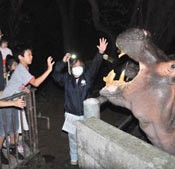
June 12, 2013 Ryukyu Shimpo
On June 8, an event entitled “Waku Waku Zoo Night” was held at the Okinawa Zoo & Museum. About 30 parents and children took part in the night event. The children became excited when they saw hippos, crocodiles, bats and other nocturnal animals.
The zoo holds the event after its normal business hours. To observe the biology of nocturnal animals and plants staff guide visitors through the quiet zoo in which the animals are sleeping.
In the animal petting area, children threw grass into the hippo’s mouth over the fence and experienced holding a Ryukyu scops owl and a megabat. They fed black swans and carp in the pond in the water and green field area.
Five-year-old Takumi Uehara, who fed to hippo said, “The hippo was huge with its mouth wide open. It was really fun to see the turtles, crocodiles and all the other animals.”
The event will be held from 7:00 p.m. to 9:00 p.m., every Saturday in June. Advance reservation is required and there is a limit of about 60 people per day. Please contact Okinawa Zoo & Museum at 098 (933) 4190 for more details.
(English translation by T&CT, Hitomi Shinzato and Mark Ealey)
Go to Japanese
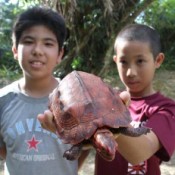
June 17, 2013 Ryukyu Shimpo
On his way to the school on May 31, eleven-year-old pupil of Ginoza Elementary School Kuruto Aniya picked up a Ryukyu leaf turtle (Ryukyu yama-game) without knowing that it is designated as a natural treasure.
Kuruto brought the turtle to school out of curiosity because he had never seen one like it before. He showed it to his science teacher Norihiro Yara, who told him, “Well, you can check this for yourself.” When he looked in an animal book and found it, he shouted, “It’s a natural treasure!”
After being contacted by the school, a researcher of the Ginoza Museum confirmed that the animal is in fact a national treasure. “This is a quite beautiful turtle. Most of the turtles are brown or yellow. Even so, we don’t know whether it is male or female, this is a very beautiful red,” one of the museum staff said. After the turtle was given appropriate care in the museum, Kuruto and his friend Shuya Tokashiki released it in the nearby woods on the afternoon of June 13.
(English translation by T&CT, Mark Ealey)
Go to Japanese












 Webcam(Kokusai Street)
Webcam(Kokusai Street)


